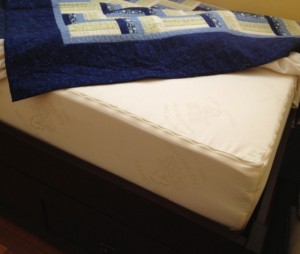Vegan Organic Mattress
Saturday, June 1st, 2013Finding a chemical-free mattress without any wool is not as easy as one might hope. It turns out that state laws dictate mattresses be fire retardant, and that means they either have chemicals or they have a layer of wool, which is supposedly a natural flame retardant. If you want to buy an organic mattress without any wool, you have to have a doctor’s note. I’m told that it doesn’t necessarily need to be a prescription and you can get the note from a naturopath.
Organic mattresses are pretty darn expensive – I’m talking over $2000 – so having to make an appointment with a doctor adds to the already steep price. And it’s a hassle.
We were looking for a twin extra-long mattress for our new guest bed and thought we’d try out these latex mattresses everyone is raving about. The one we picked was going to be around $2500 before tax or shipping. Hmm. That’s quite a lot. So we considered an organic spring mattress instead, but that was still going to cost $1600 or so. This seemed awfully excessive just for a guest bed that would hardly be used, but still, we really didn’t want a mattress with chemicals. And I really didn’t want to have to go see a doctor in order to buy a vegan mattress.
Then I came across a loop-hole. You can legally buy chemical-free wool-free mattress parts without a doctor’s note, and assemble them into a mattress yourself. Not only that, but it’s far cheaper. Our order for 3 layers of latex plus a vegan mattress cover came to $960, including shipping.
A few words of caution though. In the how-to video, Joe makes this all look very easy. A little too easy, if you ask me. The latex cores are heavy and hard to move around, although we did get better at it. The hardest part is knowing what to buy. We bought 3 layers, 3″ firm, 3″ medium, and 3″ soft, after having tried one out elsewhere that had that configuration. Turns out all latex isn’t made the same and our mattress was way too soft. The other problem was that the 3″ layers were actually only 2.75″ thick, while the mattress cover was a full 9″ tall, meaning there was 3/4 of an inch of empty space making the cover baggy.
Despite the fact that Nest Bedding’s website clearly states that the DIY components were non-refundable and non-exchangeable, Joe was completely cool about letting me exchange the soft layer for a firm. I also bought an additional layer of 2″ firm to fill up the empty space and add a little extra compression to the latex. Mailing a latex mattress core is really expensive though (just over $100) so do your best to get it right the first time, even if you are lucky enough to encounter awesome customer service.
Another warning about latex mattresses in general: they are extremely heavy and difficult to move around. It’s doable with a twin size, but I’m not sure how we’d ever be able to move a queen or king. Also, they are more floppy than a standard mattress, so they work best on a bed frame that has a solid bottom for it to rest on. They also feel a lot different than a regular mattress, so give yourself a few days to get used to it.
In the end we wound up paying around $1350 to get it right, with shipping (both ways) and everything. Still about half the cost of a similar preassembled mattress. Even though I’m quite happy with the latex mattress now, we’ll likely stick with organic futons going forward. But if you already know you want a latex mattress, buying DIY components is definitely worth considering.

![[del.icio.us]](https://www.vegangirl.com/wp-content/plugins/bookmarkify/delicious.png)
![[Digg]](https://www.vegangirl.com/wp-content/plugins/bookmarkify/digg.png)
![[Facebook]](https://www.vegangirl.com/wp-content/plugins/bookmarkify/facebook.png)
![[Google]](https://www.vegangirl.com/wp-content/plugins/bookmarkify/google.png)
![[Ma.gnolia]](https://www.vegangirl.com/wp-content/plugins/bookmarkify/magnolia.png)
![[MySpace]](https://www.vegangirl.com/wp-content/plugins/bookmarkify/myspace.png)
![[Reddit]](https://www.vegangirl.com/wp-content/plugins/bookmarkify/reddit.png)
![[StumbleUpon]](https://www.vegangirl.com/wp-content/plugins/bookmarkify/stumbleupon.png)
![[Technorati]](https://www.vegangirl.com/wp-content/plugins/bookmarkify/technorati.png)
![[Twitter]](https://www.vegangirl.com/wp-content/plugins/bookmarkify/twitter.png)
![[Yahoo!]](https://www.vegangirl.com/wp-content/plugins/bookmarkify/yahoo.png)
![[Email]](https://www.vegangirl.com/wp-content/plugins/bookmarkify/email.png)